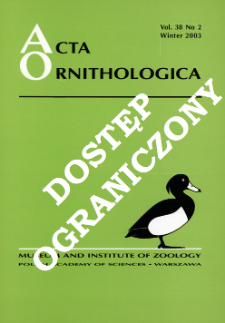- Search in all Repository
- Literature and maps
- Archeology
- Mills database
- Natural sciences
Advanced search
Advanced search
Advanced search
Advanced search
Advanced search

Object
Title: The waterbirds of the large fish pond complexes in Lithuania
Subtitle:
Acta Ornithologica, vol. 35, no. 1 ; Ptaki wodne dużych stawów rybnych na Litwie ; Waterfowl of the Lithuanian fish pond complexes
Contributor:
Polska Akademia Nauk. Muzeum i Instytut Zoologii ; Meeting of the European Ornithologists' Union (2 ; 1999 ; Gdańsk)
Publisher:
Muzeum i Instytut Zoologii PAN
Place of publishing:
Description:
Ref. wygłoszony na Second Meeting of the European Ornithologists' Union ; Bibliogr. p. 48-49 ; P. [45]-49 ; 27 cm ; Abstract in Polish. Taxa in Latin
Type of object:
Abstract:
In 1996-1999 eleven large fish pond complexes totalling about 8700 ha were investigated. About 160 species of birds have been recorded in Lithuanian fish ponds that are amongst the most important wetlands in Lithuania for nesting, moulting and staging waterbirds. Fish pond complexes supported about 20% of the individuals of the total estimated Lithuanian population of Little Grebe, about 40-50% of Red-necked and Black-necked Grebes, almost all breeding Whooper Swans in Lithuania, about 20% of the individuals of the total estimated Lithuanian population of Greylag Goose, 40% of Shelduck, 30% of Tufted Duck, more than 20% of Gadwall, Pintail and Shoveler. Certain ponds were possible breeding sites of Ferruginous Duck, a globally threatened species. The large fish pond complexes are the most important in Lithuania staging sites of Black Storks and the principal stopover sites of wildfowl with up to 30 000 staging swans, geese and ducks being daily recorded in some ponds. These man-made wetlands are amongst the most important stopover sites for many species of waders with up to 8000 Lapwings, 2600 Ruffs and 1400 Dunlins recorded in some ponds. Several large ponds complexes regularly support concentrations of Whooper Swan, White-fronted Goose, Gadwall, Shoveler, Pochard and Lapwing, exceeding the 1% Ramsar threshold. New forms of aquaculture being brought about by the market economy may affect the key waterbirds habitats in the large fish ponds.
Relation:
Volume:
Issue:
Start page:
End page:
Detailed Resource Type:
Format:
Resource Identifier:
Source:
MiIZ PAN, call no. P.257, Vol. 35, No 1 ; MiIZ PAN, call no. P.4568, Vol. 35, No 1 ; click here to follow the link
Language:
Rights:
Rights Reserved - Restricted Access
Terms of use:
Digitizing institution:
Museum and Institute of Zoology of the Polish Academy of Sciences
Original in:
Library of the Museum and Institute of Zoology of the Polish Academy of Sciences
Projects co-financed by:
Programme Innovative Economy, 2010-2014, Priority Axis 2. R&D infrastructure ; European Union. European Regional Development Fund
Access:
Object collections:
- Digital Repository of Scientific Institutes > Partners' collections > Museum and Institute of Zoology PAS > Scientific Journals
- Digital Repository of Scientific Institutes > Partners' collections > Museum and Institute of Zoology PAS > MIZ PAN Publications > Acta Ornithologica
- Digital Repository of Scientific Institutes > Literature > Journals/Articles
Last modified:
Feb 4, 2025
In our library since:
May 22, 2014
Number of object content downloads / hits:
53
All available object's versions:
https://rcin.org.pl./publication/61262
Show description in RDF format:
Show description in RDFa format:
Show description in OAI-PMH format:
| Edition name | Date |
|---|---|
| Waterbirds of the large fish pond complexes in Lithuania / Švažas, Saulius | Feb 4, 2025 |
Objects Similar
Kot, Henryk (1951– )
Reproduction and feeding success of the red-necked grebe Podiceps grisegena at fish ponds, SE Poland
Kloskowski, Janusz
Cempulik, Piotr
Dobrowolski, Kazimierz A.
Kumari, Erik Vol'demarovič (1912–1984)
Lebreton, Jean-Dominique (1950– )

 INSTYTUT ARCHEOLOGII I ETNOLOGII POLSKIEJ AKADEMII NAUK
INSTYTUT ARCHEOLOGII I ETNOLOGII POLSKIEJ AKADEMII NAUK
 INSTYTUT BADAŃ LITERACKICH POLSKIEJ AKADEMII NAUK
INSTYTUT BADAŃ LITERACKICH POLSKIEJ AKADEMII NAUK
 INSTYTUT BADAWCZY LEŚNICTWA
INSTYTUT BADAWCZY LEŚNICTWA
 INSTYTUT BIOLOGII DOŚWIADCZALNEJ IM. MARCELEGO NENCKIEGO POLSKIEJ AKADEMII NAUK
INSTYTUT BIOLOGII DOŚWIADCZALNEJ IM. MARCELEGO NENCKIEGO POLSKIEJ AKADEMII NAUK
 INSTYTUT BIOLOGII SSAKÓW POLSKIEJ AKADEMII NAUK
INSTYTUT BIOLOGII SSAKÓW POLSKIEJ AKADEMII NAUK
 INSTYTUT CHEMII FIZYCZNEJ PAN
INSTYTUT CHEMII FIZYCZNEJ PAN
 INSTYTUT CHEMII ORGANICZNEJ PAN
INSTYTUT CHEMII ORGANICZNEJ PAN
 INSTYTUT FILOZOFII I SOCJOLOGII PAN
INSTYTUT FILOZOFII I SOCJOLOGII PAN
 INSTYTUT GEOGRAFII I PRZESTRZENNEGO ZAGOSPODAROWANIA PAN
INSTYTUT GEOGRAFII I PRZESTRZENNEGO ZAGOSPODAROWANIA PAN
 INSTYTUT HISTORII im. TADEUSZA MANTEUFFLA POLSKIEJ AKADEMII NAUK
INSTYTUT HISTORII im. TADEUSZA MANTEUFFLA POLSKIEJ AKADEMII NAUK
 INSTYTUT JĘZYKA POLSKIEGO POLSKIEJ AKADEMII NAUK
INSTYTUT JĘZYKA POLSKIEGO POLSKIEJ AKADEMII NAUK
 INSTYTUT MATEMATYCZNY PAN
INSTYTUT MATEMATYCZNY PAN
 INSTYTUT MEDYCYNY DOŚWIADCZALNEJ I KLINICZNEJ IM.MIROSŁAWA MOSSAKOWSKIEGO POLSKIEJ AKADEMII NAUK
INSTYTUT MEDYCYNY DOŚWIADCZALNEJ I KLINICZNEJ IM.MIROSŁAWA MOSSAKOWSKIEGO POLSKIEJ AKADEMII NAUK
 INSTYTUT PODSTAWOWYCH PROBLEMÓW TECHNIKI PAN
INSTYTUT PODSTAWOWYCH PROBLEMÓW TECHNIKI PAN
 INSTYTUT SLAWISTYKI PAN
INSTYTUT SLAWISTYKI PAN
 SIEĆ BADAWCZA ŁUKASIEWICZ - INSTYTUT TECHNOLOGII MATERIAŁÓW ELEKTRONICZNYCH
SIEĆ BADAWCZA ŁUKASIEWICZ - INSTYTUT TECHNOLOGII MATERIAŁÓW ELEKTRONICZNYCH
 MUZEUM I INSTYTUT ZOOLOGII POLSKIEJ AKADEMII NAUK
MUZEUM I INSTYTUT ZOOLOGII POLSKIEJ AKADEMII NAUK
 INSTYTUT BADAŃ SYSTEMOWYCH PAN
INSTYTUT BADAŃ SYSTEMOWYCH PAN
 INSTYTUT BOTANIKI IM. WŁADYSŁAWA SZAFERA POLSKIEJ AKADEMII NAUK
INSTYTUT BOTANIKI IM. WŁADYSŁAWA SZAFERA POLSKIEJ AKADEMII NAUK


































